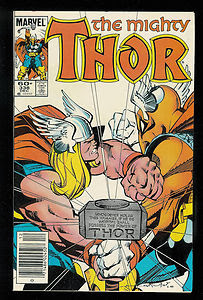.jpg) Jason Shayer
Jason ShayerJason Shayer is an expert in the field of Marvel and DC Comics. He has half a dozen short story credits and is a regular contributor to Back Issue! magazine. You an find him nostalgically revisiting the 1980s in his Blogs - Marvel 1980s and DC 1980s
Over the last 75 years, numerous surges and retreats have affected the comic book industry, both creatively and financially. In the late 1950s and early 1960s, the Silver Age of comic books heralded a successful surge as DC Comics rebooted several of their Golden Age characters and Marvel Comics adopted a fresh, new character-driven approach.
Marvel Comics experimented outside the super-hero genre in the 1970s, successfully tapping into the fantasy genre with Conan the Barbarian and the horror genre with Tomb of Dracula. In the early 1970s, Marvel Comics legendary artist Jack Kirby defected to the competition, DC Comics and created the Fourth World line of books, featuring the Forever People, Mister Miracle and the New Gods.
In the late 1970s, Jim Shooter became the editor-in-chief for Marvel Comics and ushered in what I would argue was the most significant surge of creativity since the Silver Age explosion. We had Frank Miller on Daredevil, Walt Simonson on The Mighty Thor, Chris Claremont and John Byrne on the Uncanny X-Men, John Byrne on the Fantastic Four, Roger Stern and John Buscema on the Mighty Avengers, Roger Stern and John Romita Jr. on Amazing Spider-Man, and Doug Moench and Bill Sienkiewicz on Moon Knight just to name a handful. My personal bias is showing through here, but that sheer creative energy is difficult to match.
However, once Jim Shooter read the story, he was convinced the consequences for her terrible actions weren’t high enough. The story was then rewritten and Jean Grey took her own life rather than fall victim to the power of the Dark Phoenix. Sadly, this classic storyline would be tarnished several years later with Jean Grey’s return, which not only conveniently cleared the characters of those consequences of the Dark Phoenix’s actions, but opened a revolving door for characters to return from the dead.
Shooter encouraged the evolution of the core Marvel characters. In the pages of David Michelinie and Bob Layton’s The Invincible Iron Man, Tony Stark struggled with alcoholism and was forced to let James Rhodes take over the mantle of Iron Man. While Iron Man was always one of those characters with constant upgrades and improvements to his armor, this change was more philosophical as Stark dealt with the biggest battle of his life and one that he still struggles with today.
In The Mighty Thor, Walt Simonson introduced a new ally for Thor, Beta Ray Bill, who was not only worthy of his fabled hammer, Mjolnir, but of the mantle of Thor and earned his own mystical hammer, Stormbringer. Tom DeFalco and Ron Frenz would also push that evolution, grounding Thor back to a mortal host, granting the power of Thor to Eric Masterson. Mark Gruenwald’s Captain America refuses the government’s order to become an officially sanctioned arm of the United States government and turns his uniform and shield. While Steve Rogers continued underground as The Captain, John Walker assumed the role of Captain America with more a blind, patriotic fervor.
Unfortunately, the Shooter era came to an end in 1987 when he was fired as Editor-in-Chief. While the end of his tenure is marred by a lot of personality conflicts, his legacy still stands today as having developed one of the most significant eras of comics.
DC Comics finally started to catch up to Marvel in the mid-1980s with their adult-focused titles, like Saga of the Swamp Thing and The Watchmen miniseries. From those fertile seeds, the imprint known as Vertigo was born and still continues today as a distinct publishing house of non-super heroic titles that hired now legendary creators like Neil Gaiman and Grant Morrison to really push the limits of the comic book medium.



No comments:
Post a Comment